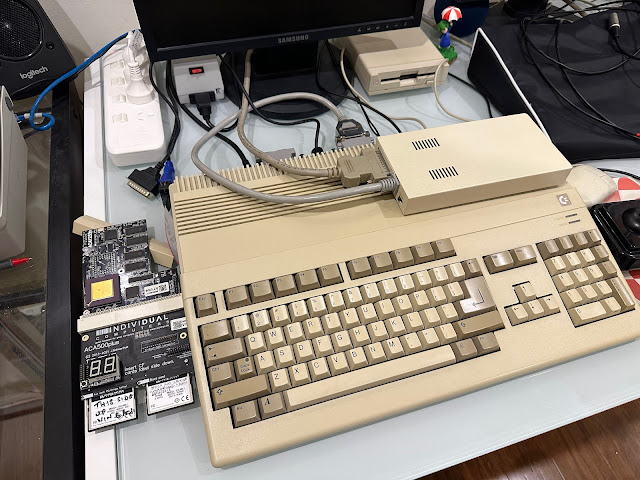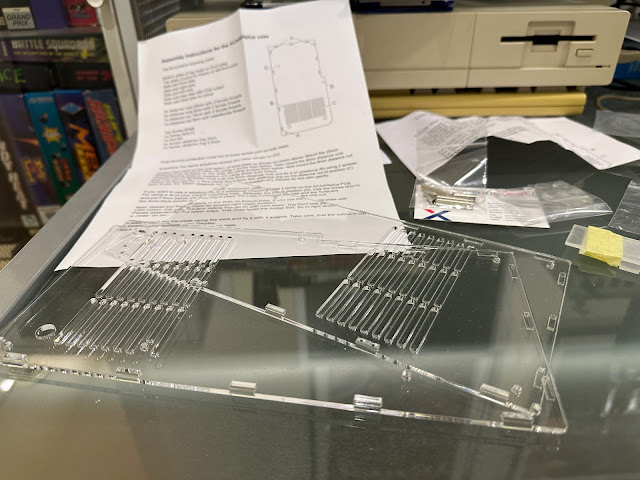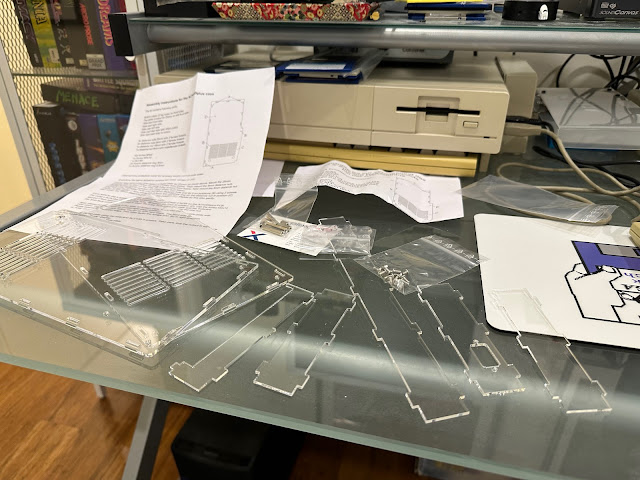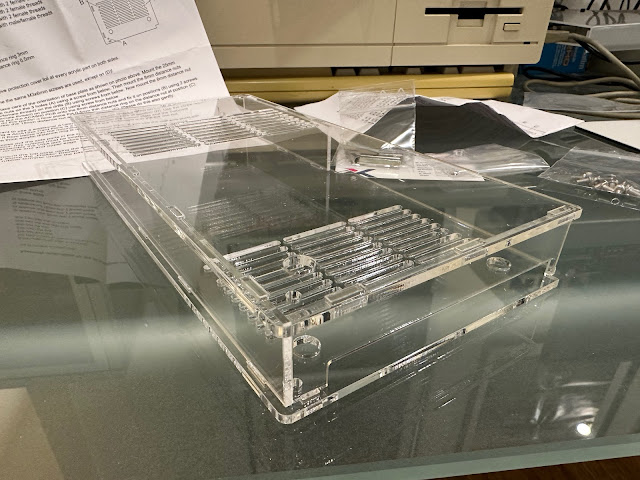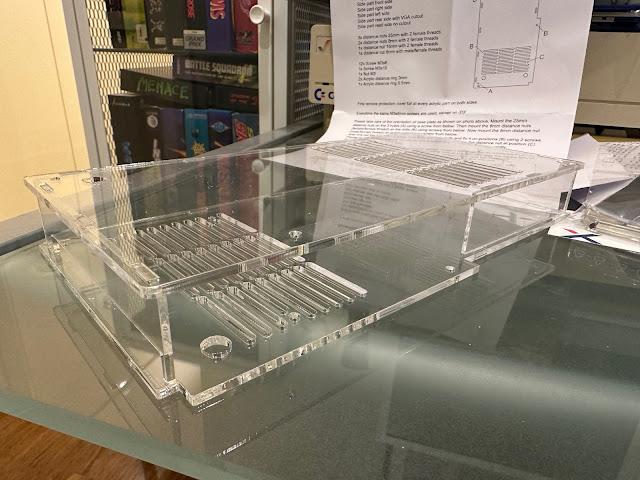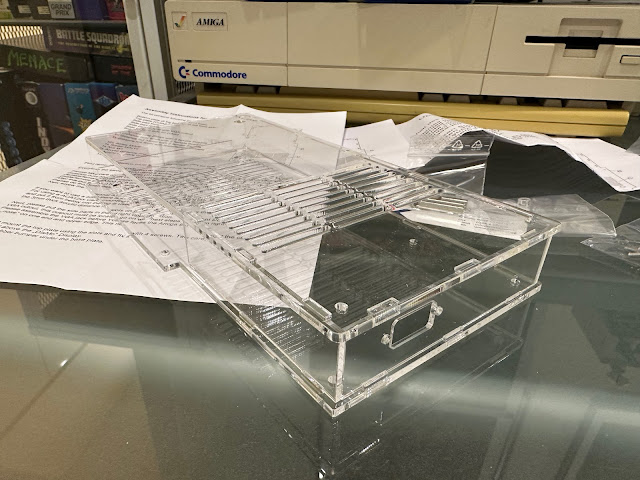Amiga 500 build Part 2 with Tank Mouse
Following on from my previous blog entry about my new Amiga 500 build, I have done a lot more with the Amiga 500 build since then, and wanted to cover it, along with looking at the new Tank mouse which arrived this week!
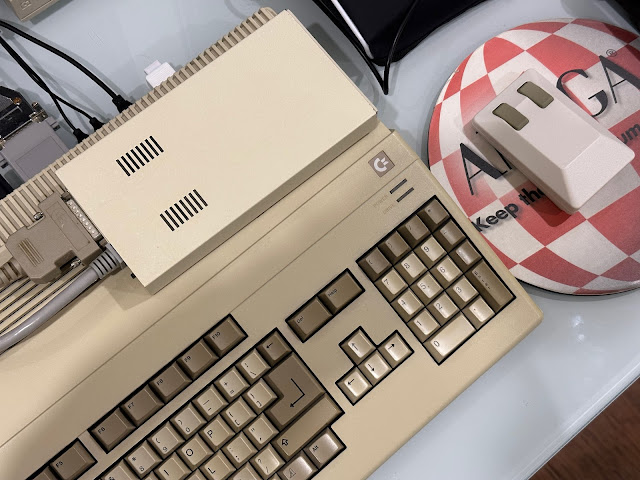
Ordering this case from Plexi Laser was a little challenging as the website is 100% in german and I can't read German at all. I used Google translate for the whole site and managed to work through the order process without a problem.
The instructions for the main case were in German and English versions. The ACA500 ethernet module instructions were only in German though..
I laid the ACA500 and accelerator on top of the base sheet, and confirmed it fits easily, as expected.
I then loosely connected the parts to make sure they fit together well before I get started on the main assembly. All looks good.
Two different rear pieces are included in the standard case, one that is just one piece with no holes in it, and one with a VGA port cutout in it.
This is great, as it means I can connect the Indivision ECS V3 VGA cable from inside through the case and mount to the rear of the ACA500 case.
I separated the accelerator from the ACA 500 and it sits perfectly at the designated locations of the screw in points I installed in the pre-drilled holes.
For the accelerator, Plexi laser have put another small hole towards the rear of the case in the right position for Individual Computers ACA1233 accelerators. Other accelerators may work also, but I didn't try them as I don't have any spares to try.
I then installed the ACA1233n accelerator and it fits perfectly, supported by the screw and nut installed.
I then use the second "nut" to secure the top of the accelerator. Using these plexiglass "nuts" I guess gives flexibility on different accelerator combinations and board thickness/height.
As I prepared the sides of the plexiglass case, it was about here that I realised I made a mistake in not checking the ACA500 ethernet module case parts first!
I took a look and realised that the plexiglass heights were different, not just the back plate to support the ethernet port.

Having instructions for the extra parts for the ethernet module that were in English and not just german only would have helped here...anyway.
I quickly hit a problem when I saw that the screw that holds the accelerator in place (that is in the same place as the whole for the ACA500 ethernet module), is not long enough to pass through both.

I quickly realised with the higher plexiglass I needed to replace the original screws to affix it to as they are too short.
I removed the ACA500 and accelerator as I needed to install the longer parts, and also find a solution for the screw (too short) that needs to hold the ACA500 and Ethernet module on one side.
Without english instructions I could read, I eventually worked out that I needed to swap the original screw plus nut integrated part with a nut:
The longer screw comes from a hole on the top of the case, and screws through a long nut into the ethernet module hole, the ACA500 hole to the base nut below!
Was a little fiddly but I got it, and its looks good and properly secured now. For plexi laser if you are reading this, please include english instructions with the ethernet module parts - it would have saved me a lot of guesswork. Hopefully this information helps anyone else trying to assemble one of these in the future.
I have an ethernet port extender on order. When it gets here I will install it into the ethernet port hole on the rear of the case.
I moved it to the Amiga 500, connected it up to the left side connector, and threaded the VGA cable through the slot gap to the Indivision ECS V3.
With that done, I reassembled the Amiga 500, which is a bit trickier now as I have to hold the plexiglass case in place with the vga cable running between them.
I imagine if I put the rapid road usb in here, it would be nice to have another plexiglass rear plate with ports for USB as well as ethernet. I suppose I could get a usb port solution vertically stacked, and use the ethernet port for USB instead, but I really wanted the network and internet connectivity. Problem for another day I guess.
Let's move onto the very excellent Tank Mouse, recently released officially for sale to the general public following the kickstarter shipped units completed, which I missed out on.

They also came with the required 9 pin to USB adapters to connect them to the Amiga (or ST or C64). They support bluetooth so you can use them directly with your modern computer without the adapters - great if you want to use them on a Raspberry Pi or similar emulated Amiga setup.
For me though, I want to use them on my actual Amiga systems. These two units are both "Amiga Beige" colour - there is a black version too which I might order later on:
The mouse takes two AAA batteries, and being modern and wireless, no annoying ball, and not a single cable in sight!
Inside the battery cover is the USB wireless connector, which needs to be plugged into the 9 pin to USB converter to use on the Amiga.
Here is a comparison of my Amiga 1000 original wired mouse and the new tank mouse. My mouse is heavily yellowed, but the dimensions and design are pretty much spot on.
The slightly thinner mouse buttons on the new tank mouse is so the scroller function between the mouse buttons can operate.
Closer view the 9 pin casing looks 3D printed and I would have liked it to be a bit closer to beige or just black would have been fine too given most joysticks use black cables anyway and would fit in nicer, but that is nitpicking:

It is so nice not to have to fight with the recalcitrant ball based mouse to move around the Workbench anymore.
I installed the other Tank mouse on the Amiga 500 I am building in this blog post next, and it works perfectly on the A500 too.
So, at this point I am very happy to have the Tank Mouse on my Amiga 500 build! I know there is a 3rd "button" scroll mouse function I should explore (assuming it works on AmigaOS), but I have run out of time to try it!
